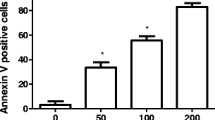Abstract
A novel polysaccharide, MEP-II, isolated from the fermentation broth of Morchella esculenta inhibited the proliferation of human hepatoma cell line (HepG2) through an apoptotic pathway. After HepG2 cells were treated with 150–600 μg MEP-II/ml, typical apoptotic characteristics including externalization of phosphatidylserine residues on the cell surface, nuclear fragmentation, chromatin condensation and cytoplasm shrinkage were observed. Furthermore, reactive oxygen species (ROS) burst and the collapse of mitochondrial membrane potential (Δψm) also occurred in HepG2 cells after incubation of 150–600 μg MEP-II/ml. The antioxidant, 1 mM N-acetyl-l-cysteine inhibited MEP-II-induced apoptosis, suggesting that ROS are the key mediators for MEP-II-induced apoptosis. MEP-II is therefore a potential anti-tumor agent that induces apoptosis of HepG2 cells through ROS generation.






Similar content being viewed by others
References
Cui J, Chisti Y (2003) Polysaccharopeptides of Coriolus versicolor: physiological activity, uses, and production. Biotechnol Adv 21:109–122
Cui FJ, Li Y, Xu YY, Liu ZQ et al (2007) Induction of apoptosis in SGC-7901 cells by polysaccharide–peptide GFPS1b from the cultured mycelia of Grifola frondosa GF9801. Toxicol In Vitro 21(3):417–427
Cui HL, Chen Y, Wang SS, Kai GQ et al (2011) Isolation, partial characterisation and immunomodulatory activities of polysaccharide from Morchella esculenta. J Sci Food Agric 91:2180–2185
Deng XK, Wu Y, Dong WL, Yin FZ et al (2006) The anti-tumor effects of alkaloids from the seeds of Strychnos nux-vomica on HepG2 cells and its possible mechanism. J Ethnopharmacol 106:179–186
Feldmann G, Haouzi D, Moreau A et al (2000) Opening of the mitochondrial permeability transition pore causes matrix expansion and outer membrane rupture in fas-mediated hepatic apoptosis in mice. Hepatogy 31:674–683
Frankfurt OS, Krishan A (2003) Apoptosis-based drug screening and detection of selective toxicity to cancer cells. Anticancer Drugs 14:555–561
Ge Q, Zhang AQ, Sun PL (2009) Purification and structural elucidation of a novel fucoglucan from the fruiting bodies of Phellinus baumii Pilat. J Sci Food Agric 89:343–348
George TC, Basiji DA, Hall BE, Lynch DH et al (2004) Distinguishing modes of cell death using the image stream multispectral imaging flow cytometer. Cytometry A 59(2):237–245
Huang HL, Chen CC, Yeh CY, Huang RL (2005) Reactive oxygen species mediation of Baizhu-induced apoptosis in human leukemia cells. J Ethnopharmacol 97:21–29
Huang QL, Jin Y, Zhang LN, Cheung PCK, Kennedy JF (2007) Structure, molecular size and antitumor activities of polysaccharides from Poria cocos mycelia produced in fermenter. Carbohydr Polym 70:324–333
Kwon KB, Kim EK, Lim JG, Jeong ES et al (2005) Molecular mechanisms of apoptosis induced by Scorpio water extract in human hepatoma HepG2 cells. World J Gastroenterol 11(7):943–947
Nitha B, Janardhanan KK (2008) Aqueous-ethanolic extract of morel mushroom mycelium Morchella esculenta, protects cisplatin and gentamicin induced nephrotoxicity in mice. Food Chem Toxicol 46:3193–3199
Nitha B, De S, Adhikari SK, Devasagayam TP, Janardhanan KK (2010) Evaluation of free radical scavenging activity of morel mushroom, Morchella esculenta mycelia: a potential source of therapeutically useful antioxidants. Pharm Biol 48:453–460
Schumacker PT (2006) Reactive oxygen species in cancer cell: live by the sword, die by the sword. Cancer Cell 8:175–176
Shi Y, Wang CH, Gong XG (2008) Apoptosis-inducing effects of two anthraquinones from Hedyotis diffusa WILLD. Biol Pharm Bull 31(6):1075–1078
Simon HU, Haj-Yehia A, Levi-Schaffer F (2000) Role of reactive oxygen species (ROS) in apoptosis induction. Apoptosis 5:415–418
Tong HB, Xia FG, Feng K, Sun GR et al (2009) Structural characterization and in vitro antitumor activity of a novel polysaccharide isolated from the fruiting bodies of Pleurotus ostreatus. Bioresour Technol 100:1682–1686
Tripathi M, Singh BK, Raisuddin S, Kakkar P (2011) Abrogation of nimesulide induced oxidative stress and mitochondria mediated apoptosis by Fumaria parviflora Lam. extract. J Ethnopharmacol 136:94–102
Xiao JX, Huang GQ, Zhu CP, Ren DD et al (2007) Morphological study on apoptosis Hela cells induced by soyasaponins. Toxicol In Vitro 21:820–826
Xu H, Sun LP, Shi YZ, Wu YH et al (2008) Optimization of cultivation conditions for extracellular polysaccharide and mycelium biomass by Morchella esculenta As 51620. Biochem Eng J 39:66–73
Yang X, Sit WH, Chan DK, Wan JM (2005) The cell death process of the anticancer agent polysaccharide-peptide (PSP) in human promyelocytic leukemic HL-60 cells. Oncol Rep 13(6):1201–1210
Ye M, Liu JK, Lu ZX, Zhao Y et al (2005) Grifolin, a potential antitumor natural product from the mushroom Albatrellus confluens, inhibits tumor cell growth by inducing apoptosis in vitro. FEBS Lett 579:3437–3443
Zhang CX, Huang KX (2006) Mechanism of apoptosis induced by a polysaccharide, from the loach Misgurnus anguillicaudatus (MAP) in human hepatocellular carcinoma cells. Toxicol Appl Pharmacol 210:236–245
Zhang M, Cui SW, Cheng PCK, Wang Q (2007) Antitumor polysaccharides from mushrooms: a review on their isolation process, structural characteristics and antitumor activity. Trends Food Sci Technol 18:4–19
Acknowledgments
The authors gratefully acknowledge the financial support of this study by Foundation for Key Research Program of Education Department of Anhui Province, China (KJ2009A172, KJ2011A017) and National Natural Science Foundation of China (30800194).
Author information
Authors and Affiliations
Corresponding author
Rights and permissions
About this article
Cite this article
Hu, M., Chen, Y., Wang, C. et al. Induction of apoptosis in HepG2 cells by polysaccharide MEP-II from the fermentation broth of Morchella esculenta . Biotechnol Lett 35, 1–10 (2013). https://doi.org/10.1007/s10529-012-0917-4
Received:
Accepted:
Published:
Issue Date:
DOI: https://doi.org/10.1007/s10529-012-0917-4




